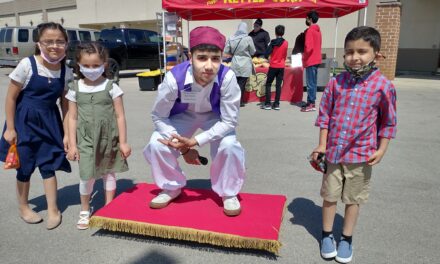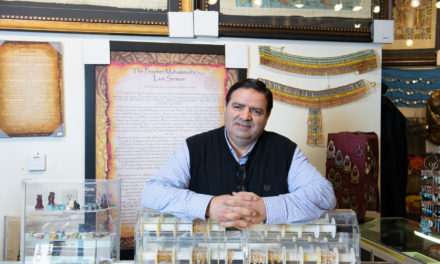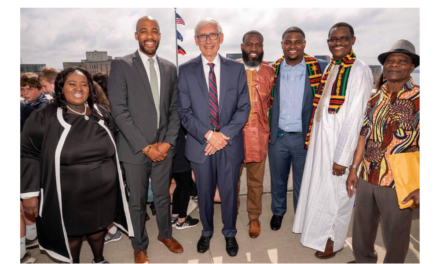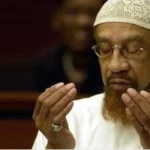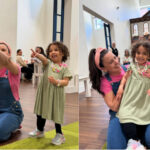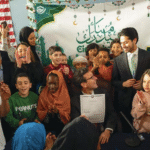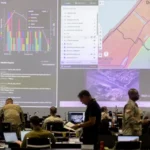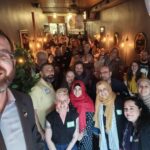
Photos by Sandra Whitehead
Chicago emergency medicine physician Thaer Ahmad, M.D., talks about recent experiences in Gaza, serving patients wounded by the Israeli military.
“We’ve reached a point where it not a single truck of medical aid or humanitarian supplies have entered into the Gaza Strip, the longest period when there has been a total shutdown of the borders, said Chicago trauma surgeon Thaer Ahmad, M.D., last week at the opening session of the Wisconsin Institute for Peace and Conflict Studies 40th annual conference, hosted by Marquette University.
Ahmad offered an eyewitness account on the current situation in Gaza as a member of a panel that also included prominent civil rights attorney and co-founder of the International Solidarity Movement Huwaida Arraf and Jewish Voice for Peace human rights advocate Julie Kosowski. Conference organizer and WIPCS executive board member Louise Cainkar, Ph.D., an MU professor and director of the university’s Interdisciplinary Peace Studies Program, served as moderator of the plenary session, held April 3 at the Central United Methodist Church in Milwaukee.
WIPCS executive director Jennifer Collins called the panel “an important opening” for a conference “centered on issues of peace and social justice.”
WIPCS is a consortium of universities, colleges and individuals “dedicated to promoting an informed understanding of peace, justice and conflict and to encouraging students, teachers, academics and the public to become engaged global citizens working toward a just peace,” its website states. “It seeks to help sustain and promote peace studies, programs, education and activism in our state—a mission that today is more critical than ever,” Collins said.
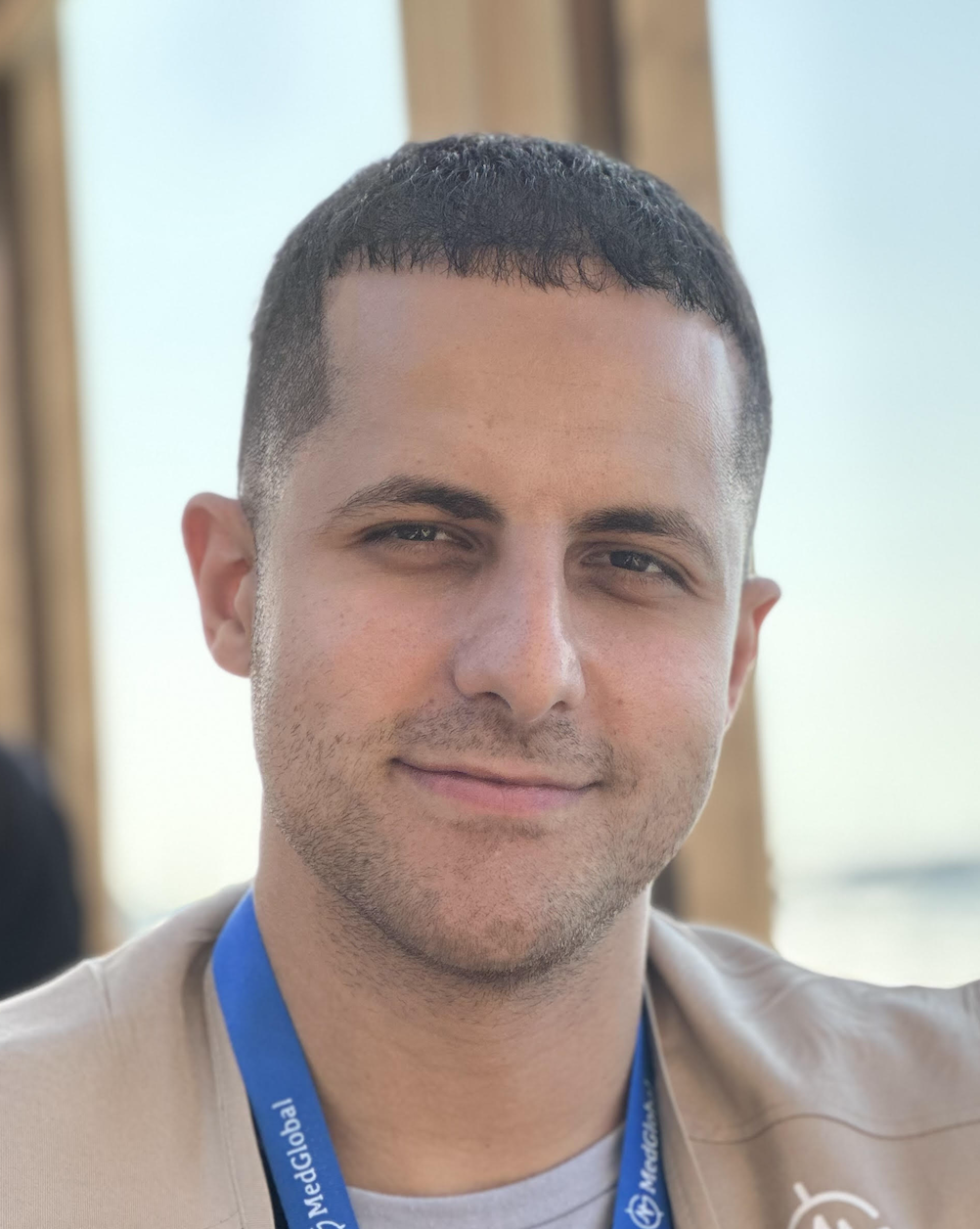
Thaer Ahmad, M.D., Emergency Medicine
For one month, “nothing has entered the Gaza Strip, and there have been only two medical evacuations out of Palestinian patients who need live-saving care,” Dr. Ahmad told a small audience gathered in the church sanctuary.
Dr. Ahmad, a Chicago emergency room physician and clinical assistant professor at the University of Illinois at Chicago, has delivered emergency medical care in Gaza and Lebanon, where hospitals and healthcare workers have come under direct Israeli military attack since October 2023. He spent three weeks in early 2024 volunteering at Nasser Hospital in Khan Younis until it stopped functioning following a siege by Israeli forces.
A year ago, Dr. Ahmad famously walked out of a meeting at the White House with President Joe Biden. He told NPR he wanted “It to be clear that up until now—what the White House has done is not sufficient enough.” He speaks and writes frequently in the media about the catastrophic conditions in Gaza, including at CNN, the New York Times, the Chicago Tribune, Al Jazeera, Democracy Now, the Chicago Sun Times, AA (a Turkish English news site) and many more.
A desperate moment
Dr. Ahmad described the current situation as “a desperate moment” in Gaza. “Everything has come to a screeching halt in terms of services and supplies. The Israelis say they are going to cut off the limited amount of electricity they supply. They already cut off the majority after Oct. 7. Now they’re cutting off any sort of electricity and fuel needed to power generators for hospitals, shelters and the water infrastructure.
“This is all taking place with a resumption of an intense amount of bombing, ground invasions and an assault on life in the Gaza Strip. The Israelis have broken the ceasefire and they have done so in a very violent and deadly way.
“First, they hit the UN Guest House in early March when they decided to throw the ceasefire away. This is important for a couple of reasons. Number One, the coordinates have been shared with the Israelis for over six months. They know exactly where this place is. They know exactly who is in this place. They know UN workers are there. They know all the movements every single day prior to any movement of these team members. This is all information that the Israelis have and it is updated every day.
“The Guest House was still hit. One person was killed and six people were injured, many of whom lost limbs as a result.
“Incident Number two, Nasser Hospital, the hospital where I worked earlier last year, became the largest remaining functioning hospital in Gaza after Al-Shifa was destroyed (in March 2024). It was where all the specialists were, where there were multiple operating rooms, where you could donate blood. It was burned to a crisp by the Israeli military.
“Then Nasser became the medical hub where most of the international medical organizations were housing their staff—Doctors Without Borders, the International Red Cross, everybody. The Israelis hit this hospital. They said they were targeting a Hamas person. This happened without warning of any sort to the administration of Nasser. You’d think they would tell them you may want to move people away from this area. It was hit when there were many American, Palestinian, British and Irish international workers there sleeping.
“Next there was the Turkish Friendship Cancer Hospital, the only cancer hospital in Gaza. It was blown up with explosives. It took almost a decade to build this hospital because of the siege on Gaza that has been in place since 2006.
“Cancer care was one of the bright spots where we were making a tremendous amount of development. Despite the siege, despite the Israeli government rejecting over 70% of our requests for medical supplies, Palestinians in Gaza were able to build a cancer hospital.
“It was clear there was nothing going on at this hospital. The Israeli military would house troops there. To blow up this hospital, a $50 million cancer care center is … too much.”
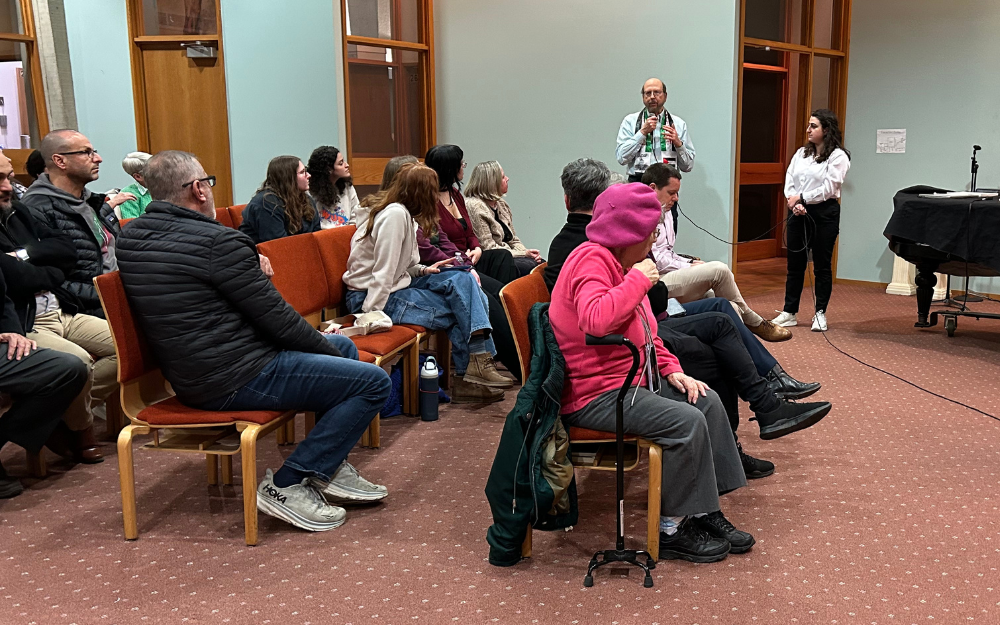
“Very alarming things have been mentioned tonight,” said Steve Watrous, United Nations Milwaukee Chapter president. He wondered about the forces working behind the scenes, adverse to the rule of law.
“Finally, very tragically, last week the Palestinian Red Crescent announced they had lost contact with eight of their workers. The Palestinian Civil Defense said they had lost contact with seven workers and UN team members. These people were responding to calls in Rafah, trying to help the wounded. They were in their ambulances.
“For seven days, every single day, the Palestinian Red Crescent would try to reach out to Israeli authorities to get permission to go look for their lost team members, paramedics, first responders. Every day, they were posting how they had asked for permission to go and that they were being ignored. And that the Israeli response was, we don’t know what you’re talking about.
“Finally, on the eighth day, they were allowed to go look for them. And they found a mass grave with all 15 of these first responders in it and their ambulances nearby, some with bullet holes in them, some blown up.
“All of them had been killed one by one, some of them in the back of their ambulances, shot in the head or in the chest. That is what the UN report says. This is a war crime. This is one of the most inhumane and evil things that has ever been done to healthcare workers. This is a war waged against every facet of society, including health care workers.”
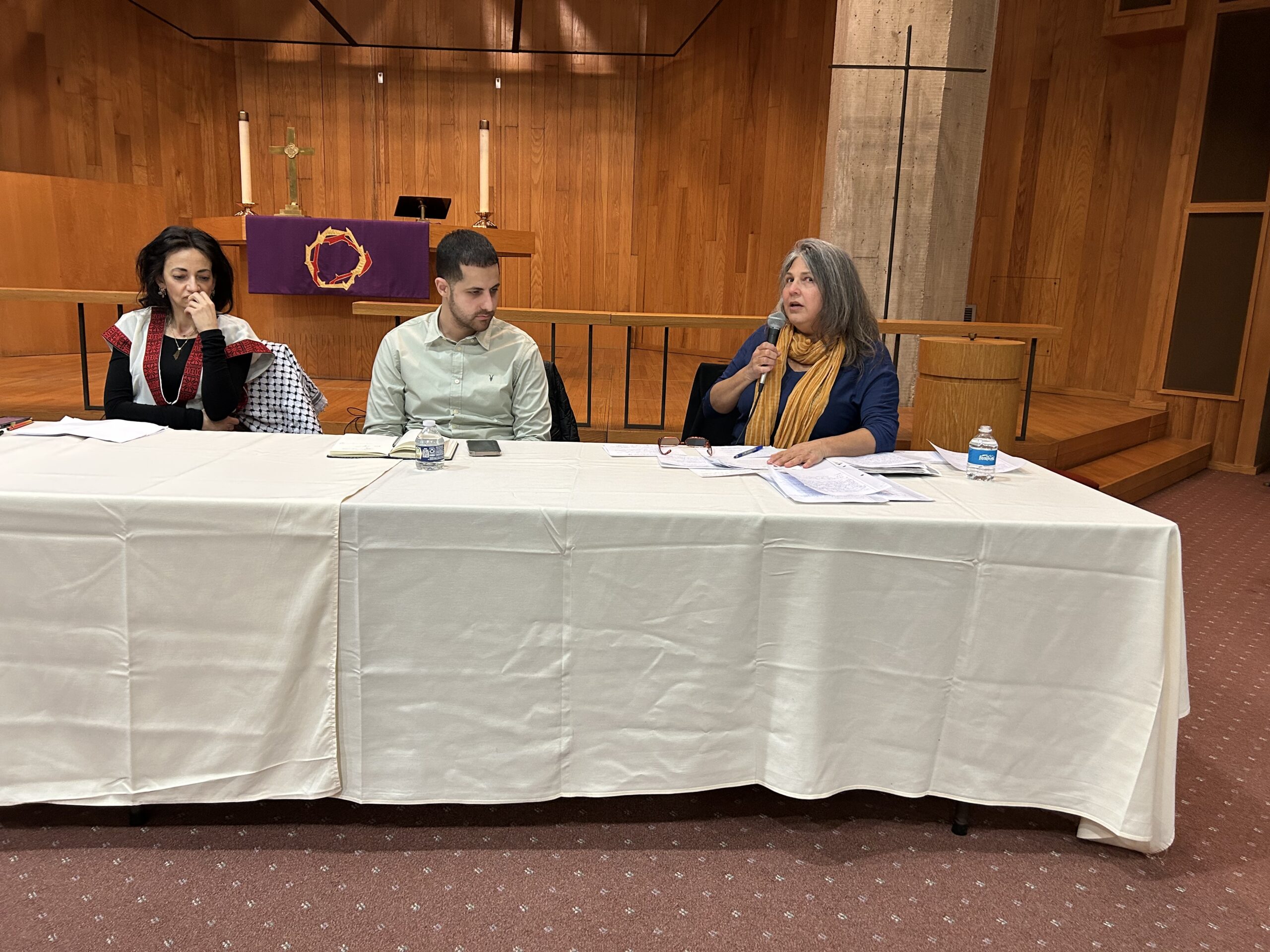
Julie Kosowski (right), a Jewish Voice for Peace human rights advocate, was one of 100 protesters arrested in November 2023 at a ceasefire demonstration in Chicago.
A disturbing trend
“Now I want to take a step back from the present moment to look at a disgusting trend,” Dr. Ahmad said. “I’ve had firsthand experience in having worked in the Gaza Strip for over 15 years, back and forth. What I’ve seen is Israel has normalized attacking life, destroying water infrastructure, bombing schools, going after academics.
“Something I have witnessed firsthand is the assault on the healthcare system, the specific targeting of the healthcare system and healthcare workers. This is going to pose a problem for many different conflicts around the globe.
“Al-Shifa was the place I would go to most. It was an incredible institution. All of the medical students and the residents who were training in Gaza come through Al-Shifa. That’s where they would learn.
“That’s where people could get care. There were only two MRI machines in Gaza and one was at Al-Shifa. You could go there to get treatment for blocked arteries, there was a maternity ward, a children’s hospital. There were intelligent, resourceful and resilient physicians who had endured many previous attacks and were also living under siege. They faced a challenging time to grow professionally,” Dr. Ahmad continued.
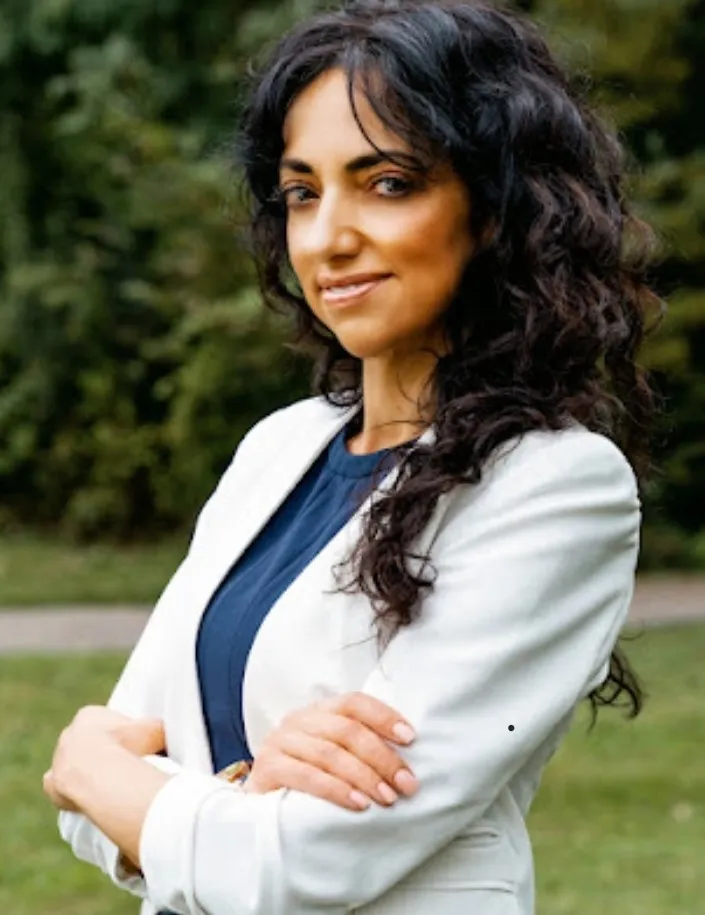
Huwaida Arraf, civil rights attorney and co-founder of the International Solidarity Movement
“One person there was famous—Dr. Adnan Bush, an orthopedic surgeon. Everybody knew him. When Al-Shifa came under siege in November 2023, the Israeli military surrounded Al-Shifa for 40 days and cut it off from any fuel. The solar panels on the roof were bombed and a kid on the roof was killed in the process.
“There were opportunities for people to leave, but the doctors and the administration felt they didn’t want to leave the hospital empty, and then raided and destroyed. They felt it was important to take a stand in that moment. Dr. Bush was one of the people who stayed.
“In the final days of the siege, before the Israeli military totally ransacked the hospital and abducted many of the healthcare workers, Dr. Bush talked to media about the conditions in the hospital and how there were some critically ill patients there. After that, he was abducted.
“The next time we heard about Dr. Bush, we learned his dead and naked body was in the courtyard of a prison where he had been tortured to death.
“This was a direct message to the rest of the healthcare workers—’When we say leave a hospital, leave or you’ll suffer a similar fate.’
“As recently as December, Dr. Hussam Abu Safiya was taken by Israel from Kamal Adwan Hospital (the last major functioning health facility in northern Gaza). Dr. Husam is now in an Israeli prison, held without charge. I just spoke to his son about an hour ago and he has just been told his father’s detention will be extended for six months.
“Dr. Hussam has written two op-eds in the New York Times about the conditions at the hospital, about the necessity to keep it open to treat patients in the pediatric intensive care unit.
“When Israelis put the hospital under siege in late October, Dr. Hussam’s oldest son, who was with him at the hospital compound, was killed by an Israeli airstrike. We had to watch Dr. Hussam bury his son in the hospital compound and pray over his body. Then a month later, when the Israeli military surrounded the hospital, Dr. Hussam had to walk up to a tank in his white coat and shake the hand of an Israeli soldier.
“Then he himself was abducted. He still has not been charged of any crime and no evidence has been brought against him. The hospital he worked hard to support and desperately tried to protect has been reduced to rubble. And Dr. Hussam is one of 250 healthcare workers that are in Israeli dungeons.
“Whether it’s the water engineers who want to restore the water infrastructure or humanitarian aid workers or people operating soup kitchens, if doctors and nurses are being abducted and killed what do we think is going to happen to the rest of the workers there?
“The sort of psychological warfare that’s being deployed on anybody who’s trying to do anything that may help rebuild the community reverberates.
“I think it’s on us, on everybody here, to mention the names of some of the people that we talked about, like Dr. Adnan or Dr. Hussam or any of the Palestinian Red Crescent workers. We can talk about the plight of the human beings in a very real way, as opposed to just citing statistics.
“We have to move the conscience of the rest of the world … There has been a purposeful dehumanization of Palestinians. We can combat that. We can do it by mentioning these names, these stories.”

